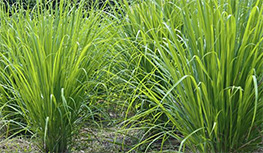AgTechNews.com
Crop Cultivation Guidence
Lemon Grass

Introduction
Botanical name – Cymbopogon flexuosus
Common name – Lemon grass
It belongs to the family of Gramineae
Three types of lemon
grasses viz. East Indian lemongrass. West Indian lemon grass (C.citratus), and Jammu lemon
grass (C.pendulus) are in cultivation in our country as the important sources of cirtral.
Uses
The chief constituent of the oil is the citral, It is starting material for the preparation of
important ionone viz., a -lonone – used in flavours, cosmetics and perfume and b
-Ionone – used in the manufacture of synthetic vitamin A. Oil has bactericidal,
insect repellent and medicinal uses. The spent grass is a source of good cattle feed and
can be converted into good silage.
Spent grasses are also
useful for the manufacture of cardboards and papers or as fuel.
Package of cultivation practices
Climate and Soil
The plants are hardy
and grow under a variety of conditions. The most ideal conditions are a warm and humid
climate with plenty of sunshine and rainfall of 250-280 cm per annum, uniformly
distributed. Regarding the soil, it can be grown from poor soils, in the hill slopes. Soil
pH ranging from 4.5 to 7.5 is ideal. As it has good soil binding nature, they can be grown
as vegetative cover over naked eroded slopes.
Varieties
The Medicinal and
Aromatic Plants Research Station, Odakkali (Kerala) and CIMAP, Lucknow has developed
improved strains viz., OD-19 and SD-68 respectively as a result of breeding and selection.
The important features of these varieties are given below. These two improved varieties
are now recommended for wide cultivation. Recently the RRL, Jammu has developed a hybrid
strain CKP-25 by crossing C.khasianus and C.pendulus which is capable of yielding 50% and
140% more oil yield than RRL-16 and OD-19 respectively.
Nursery
The soil should be
well pulverized for forming the seedbed and it should be a raised bed one. Leaf mould and
farmyard manure is also added to the soil while forming the bed. 15-20 kg of seeds are
required for raising seedlings for one hectare. Seeds are sown in lines drawn at 10 cm
interval in the beds and covered with cut grass materials. When the seedlings are about 2
months old or about 12 to 15 cm high, they are ready for transplanting.
Field preparation
The land is cleared of
the underground vegetation and pits of 5 cm cube are made at a spacing of 15 x 10 cm.
Splits for old clumps can also be used for propagation.
Manures and fertilizers
The Aromatic Plants
Research Station Odakkali (Kerala) recommends 100 kg of N/ha. Under North East conditions,
application of 60kg of N, 50 kg P and 35 kg K is recommended per hectare. In North India,
Jammu lemon grass (C.pendulus) is cultivated under irrigated condition as a source of
citral. The cultural practices are almost similar to East India lemon grass. It is
propagated exclusively by slips, which are planted on flat beds. A spacing of 50 x 50cm is
adopted. A dose of 260 kg N, 80 kg P2O5 and 120 kg K2O
per hectare is recommended in 3-4 split doses. The crop responds to irrigation especially
during hot summer months.
Harvesting
Lemon grass comes to
harvest 90 days after planting and subsequently it is harvested at 50-55 days interval.
The grass is cut 10 cm above the ground level and 5-6 cuttings can be taken in a year
subject to the climatic conditions. Depending upon the soil and climatic condition, the
crop can be retained in the field for 5 to 6 years. Depending upon the planting period,
one or two cuttings are taken in the first year and from second year onwards, 3-4 cuttings
are available. Harvesting consists of fresh leaves and also the dry or semi-dried leaves
at intervals of 60 days. The crop should not be allowed to flower profusely as it reduces
the overall yield.
Processing facilities
On an average 25 kg of oil can be obtained from first year per hectare plantation and about 80 to 100 kg of oil per year from first year 2nd to 6th year if well maintained
Markets
Its oil is popularly known as "Cochin oil" as it is hiped mainly through Cochin port. India is annually producing nearly 1000 MT per year while the world demand is much more. Annually, we are exporting lemon grass oil to a tune of about Rs. 5 crores. Our country is facing a critical competition from Gautemala in the international market.




